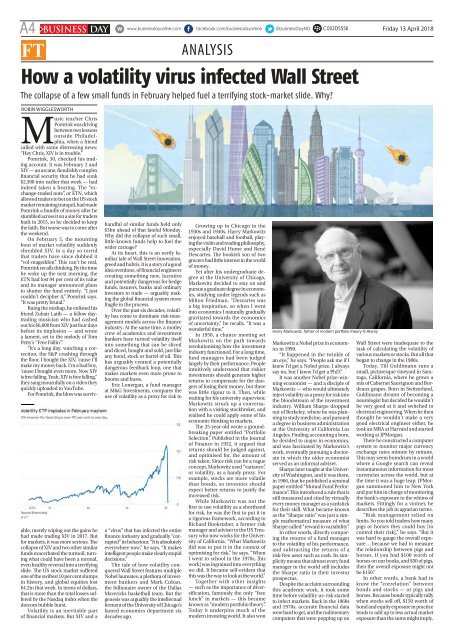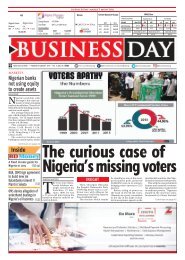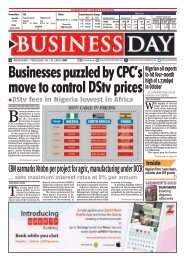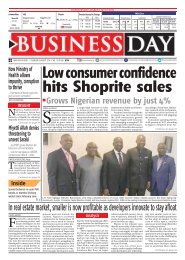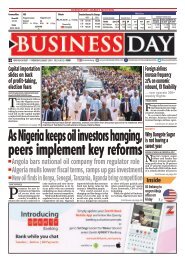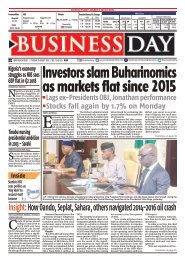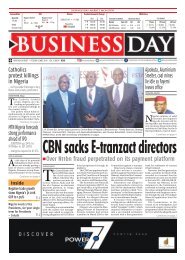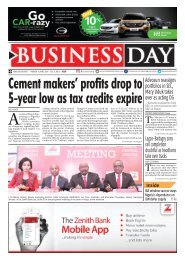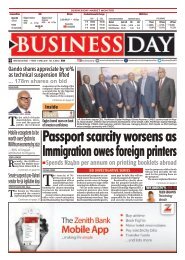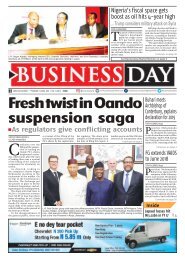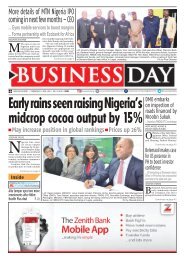BusinessDay 13 April 2018
You also want an ePaper? Increase the reach of your titles
YUMPU automatically turns print PDFs into web optimized ePapers that Google loves.
A4 BUSINESS DAY<br />
C002D5556 Friday <strong>13</strong> <strong>April</strong> <strong>2018</strong><br />
FT<br />
ANALYSIS<br />
How a volatility virus infected Wall Street<br />
The collapse of a few small funds in February helped fuel a terrifying stock-market slide. Why?<br />
ROBIN WIGGLESWORTH<br />
Music teacher Chris<br />
Pomrink was driving<br />
between two lessons<br />
outside Philadelphia,<br />
when a friend<br />
called with some distressing news:<br />
“Hey Chris, XIV is in trouble.”<br />
Pomrink, 30, checked his trading<br />
account. It was February 2 and<br />
XIV — an arcane, fiendishly complex<br />
financial security that he had sunk<br />
$2,500 into earlier that week — had<br />
indeed taken a beating. The “exchange-traded<br />
note”, or ETN, which<br />
allowed traders to bet on the US stock<br />
market remaining tranquil, had made<br />
Pomrink a bundle of money after he<br />
stumbled across it on a site for traders<br />
back in 2015, so he decided to keep<br />
the faith. But worse was to come after<br />
the weekend.<br />
On February 5, the mounting<br />
bout of market volatility suddenly<br />
shredded XIV, in a day so torrid<br />
that traders have since dubbed it<br />
“vol-mageddon”. This can’t be real,<br />
Pomrink recalls thinking. By the time<br />
he woke up the next morning, the<br />
ETN had lost 94 per cent of its value<br />
and its manager announced plans<br />
to shutter the fund entirely. “I just<br />
couldn’t decipher it,” Pomrink says.<br />
“It was pretty brutal.”<br />
Ruing the mishap, he enlisted his<br />
friend Zubair Latib — a fellow daytrading<br />
musician who had cashed<br />
out his $6,000 from XIV just four days<br />
before its implosion — and wrote<br />
a lament, set to the melody of Tom<br />
Petty’s “Free Fallin’”.<br />
“It’s a long day, watching a correction,<br />
the S&P crashing through<br />
the floor. I bought the XIV, ’cause I’ll<br />
make my money back. I’m a bad boy,<br />
’cause I bought even more. Now XIV<br />
is free falling. Yeah, XIV is free falling,”<br />
they sang mournfully on a video they<br />
quickly uploaded to YouTube.<br />
For Pomrink, the blow was surviv-<br />
able, merely wiping out the gains he<br />
had made trading XIV in 2017. But<br />
for markets, it was more serious. The<br />
collapse of XIV and two other similar<br />
funds exacerbated the turmoil, turning<br />
what could have been a normal,<br />
even healthy reversal into a terrifying<br />
slide. The US stock market suffered<br />
one of the swiftest 10 per cent slumps<br />
in history, and global equities lost<br />
$4.2tn that week. In terms of dollars,<br />
that is more than the total losses suffered<br />
by the Nasdaq index when the<br />
dotcom bubble burst.<br />
Volatility is an inevitable part<br />
of financial markets. But XIV and a<br />
handful of similar funds held only<br />
$3bn ahead of that fateful Monday.<br />
Why did the collapse of such small,<br />
little-known funds help to fuel the<br />
wider carnage?<br />
At its heart, this is an eerily familiar<br />
tale of Wall Street innovation,<br />
greed and hubris. It is a story of a good<br />
idea overdone, of financial engineers<br />
creating something new, lucrative<br />
and potentially dangerous for hedge<br />
funds, insurers, banks and ordinary<br />
investors to trade — arguably making<br />
the global financial system more<br />
fragile in the process.<br />
Over the past six decades, volatility<br />
has come to dominate risk-management<br />
models across the finance<br />
industry. At the same time, a motley<br />
crew of academics and investment<br />
bankers have turned volatility itself<br />
into something that can be sliced<br />
and diced, bought and sold, just like<br />
any bond, stock or barrel of oil. This<br />
has arguably created a potentially<br />
dangerous feedback loop, one that<br />
makes markets even more prone to<br />
booms and busts.<br />
Eric Lonergan, a fund manager<br />
at M&G Investments, compares the<br />
use of volatility as a proxy for risk to<br />
a “virus” that has infected the entire<br />
finance industry and gradually “corrupted”<br />
its behaviour. “It is absolutely<br />
everywhere now,” he says. “It makes<br />
intelligent people make clearly stupid<br />
decisions.”<br />
The tale of how volatility conquered<br />
Wall Street features multiple<br />
Nobel laureates, a plethora of investment<br />
bankers and Mark Cuban,<br />
the billionaire owner of the Dallas<br />
Mavericks basketball team. But the<br />
genesis was arguably the intellectual<br />
ferment of the University of Chicago’s<br />
famed economics department six<br />
decades ago.<br />
Growing up in Chicago in the<br />
1930s and 1940s, Harry Markowitz<br />
enjoyed baseball and football, playing<br />
the violin and reading philosophy,<br />
especially David Hume and René<br />
Descartes. The bookish son of two<br />
grocers had little interest in the world<br />
of money.<br />
Yet after his undergraduate degree<br />
at the University of Chicago,<br />
Markowitz decided to stay on and<br />
pursue a graduate degree in economics,<br />
studying under legends such as<br />
Milton Friedman. “Descartes was<br />
a big inspiration, so when I went<br />
into economics I naturally gradually<br />
gravitated towards the economics<br />
of uncertainty,” he recalls. “It was a<br />
wonderful time.”<br />
In 1950, a chance meeting set<br />
Markowitz on the path towards<br />
revolutionising how the investment<br />
industry functioned. For a long time,<br />
fund managers had been judged<br />
largely by their performance. People<br />
intuitively understood that riskier<br />
investments should generate higher<br />
returns to compensate for the dangers<br />
of losing their money, but there<br />
was little rigour to it. Then, while<br />
waiting for his university supervisor,<br />
Markowitz struck up a conversation<br />
with a visiting stockbroker, and<br />
realised he could apply some of his<br />
economic thinking to markets.<br />
The 25-year-old wrote a groundbreaking<br />
paper entitled “Portfolio<br />
Selection”. Published in the Journal<br />
of Finance in 1952, it argued that<br />
returns should be judged against,<br />
and optimised for, the amount of<br />
risk taken. Since risk can be a vague<br />
concept, Markowitz used “variance”,<br />
or volatility, as a handy proxy. For<br />
example, stocks are more volatile<br />
than bonds, so investors should<br />
expect better returns to justify the<br />
increased risk.<br />
While Markowitz was not the<br />
first to use volatility as a shorthand<br />
for risk, he was the first to put it in<br />
a rigorous framework, according to<br />
Richard Bookstaber, a former risk<br />
manager and adviser to the US Treasury<br />
who now works for the University<br />
of California. “What Markowitz<br />
did was to put it in the context of<br />
optimising for risk,” he says. “When<br />
I went to school in the 1970s, [his<br />
work] was ingrained into everything<br />
we did. It became self-evident that<br />
this was the way to look at the world.”<br />
Together with other insights<br />
— such as the importance of diversification,<br />
famously the only “free<br />
lunch” in markets — this became<br />
known as “modern portfolio theory”.<br />
Today it underpins much of the<br />
modern investing world. It also won<br />
Harry Markowitz, father of modern portfolio theory © Alamy<br />
Markowitz a Nobel prize in economics<br />
in 1990.<br />
“It happened in the twinkle of<br />
an eye,” he says. “People ask me if I<br />
knew I’d get a Nobel prize. I always<br />
say no, but I knew I’d get a PhD.”<br />
It was another Nobel prize-winning<br />
economist — and a disciple of<br />
Markowitz — who would ultimately<br />
inject volatility as a proxy for risk into<br />
the bloodstream of the investment<br />
industry. William Sharpe dropped<br />
out of Berkeley, where he was planning<br />
to study medicine, and pursued<br />
a degree in business administration<br />
at the University of California Los<br />
Angeles. Finding accounting a bore,<br />
he decided to major in economics,<br />
and was fascinated by Markowitz’s<br />
work, eventually pursuing a doctorate<br />
in which the older economist<br />
served as an informal adviser.<br />
Sharpe later taught at the University<br />
of Washington, and it was there,<br />
in 1966, that he published a seminal<br />
paper entitled “Mutual Fund Performance”.<br />
This introduced a rule that is<br />
still measured and cited by virtually<br />
every money manager as a yardstick<br />
for their skill. What became known<br />
as the “Sharpe ratio” was just a simple<br />
mathematical measure of what<br />
Sharpe called “reward to variability”.<br />
In other words, directly comparing<br />
the returns of a fund manager<br />
to the volatility of his performance,<br />
and subtracting the returns of a<br />
risk-free asset such as cash. Its simplicity<br />
means that almost every fund<br />
manager in the world still includes<br />
the Sharpe ratio in their investor<br />
prospectus.<br />
Despite the acclaim surrounding<br />
this academic work, it took some<br />
time before volatility-as-risk started<br />
to infect markets. Back in the 1960s<br />
and 1970s, accurate financial data<br />
were hard to get, and the rudimentary<br />
computers that were popping up on<br />
Wall Street were inadequate to the<br />
task of calculating the volatility of<br />
various markets or stocks. But all that<br />
began to change in the 1980s.<br />
Today, Till Guldimann runs a<br />
small, picturesque vineyard in Saratoga,<br />
California, where he grows a<br />
mix of Cabernet Sauvignon and Bordeaux<br />
grapes. Born in Switzerland,<br />
Guldimann dreamt of becoming a<br />
neurologist but decided he wouldn’t<br />
be very good at it and switched to<br />
electrical engineering. When he then<br />
thought he wouldn’t make a very<br />
good electrical engineer either, he<br />
took an MBA at Harvard and started<br />
working at JPMorgan.<br />
There he constructed a computer<br />
system to monitor major currency<br />
exchange rates minute by minute.<br />
This may seem humdrum in a world<br />
where a Google search can reveal<br />
instantaneous information for most<br />
currencies across the world, but at<br />
the time it was a huge leap. JPMorgan<br />
summoned him to New York<br />
and put him in charge of monitoring<br />
the bank’s exposure to the whims of<br />
markets. Fittingly for a vintner, he<br />
describes the job in agrarian terms.<br />
“Risk management relied on<br />
limits. So you told traders how many<br />
pigs or horses they could buy [to<br />
control their risk],” he says. “But it<br />
was hard to gauge the overall exposure<br />
. . . because we had to measure<br />
the relationship between pigs and<br />
horses. If you had $100 worth of<br />
horses on our books, and $50 of pigs,<br />
then the overall exposure might not<br />
be $150.”<br />
In other words, a bank had to<br />
know the “correlation” between<br />
bonds and stocks — or pigs and<br />
horses. Because bonds typically rally<br />
when stocks sell off, $150 worth of<br />
bond and equity exposure in practice<br />
tends to add up to less actual market<br />
exposure than the sums might imply.


